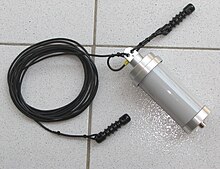
Back Langdrahtantenne German Pitkälanka-antenni Finnish Antenne long-fil French Antenna random wire Italian Antena long wire Polish

A random wire antenna is a radio antenna consisting of a long wire suspended above the ground, whose length does not bear a particular relation to the wavelength of the radio waves used, but is typically chosen more for convenient fit between the available supports, or the length of wire at hand, rather than selecting length to be resonant on any particular frequency. The wire may be straight or it may be strung back and forth between trees or walls just to get as much wire into the air as feasible. Due to the great variability of the (unplanned) antenna structure, the random wire’s effectiveness can vary erratically from one installation to another, and a single random wire antenna can have wildly different reception / transmission strength in one direction than it achieves in another azimuth direction about 70°~140° different, and finally reception / transmission strengths and directions can be wildly different on only moderately different frequencies. Random wire antennas are typically fed at one end against a suitable counterpoise (such as earth ground or a parallel wire hidden under the grass below the elevated antenna wire).
They are widely used as receiving antennas on the long wave, medium wave, and short wave bands, as well as transmitting antennas on these bands for small outdoor, temporary or emergency transmitting stations, as well as in situations where more permanent antennas cannot be installed.
© MMXXIII Rich X Search. We shall prevail. All rights reserved. Rich X Search